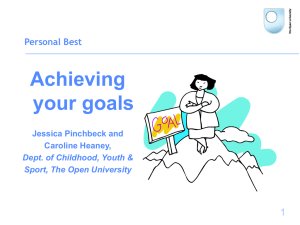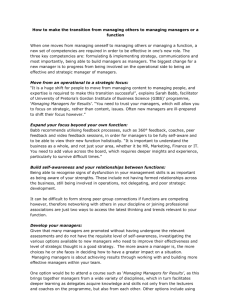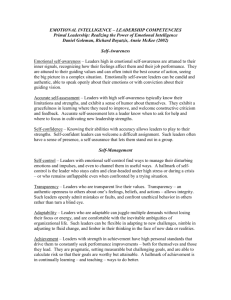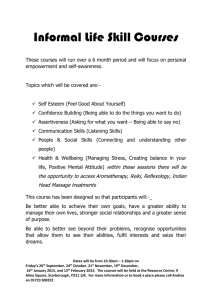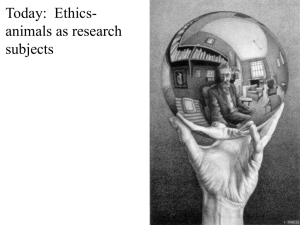Unit 6: Increasing My Self-Awareness Lesson
advertisement
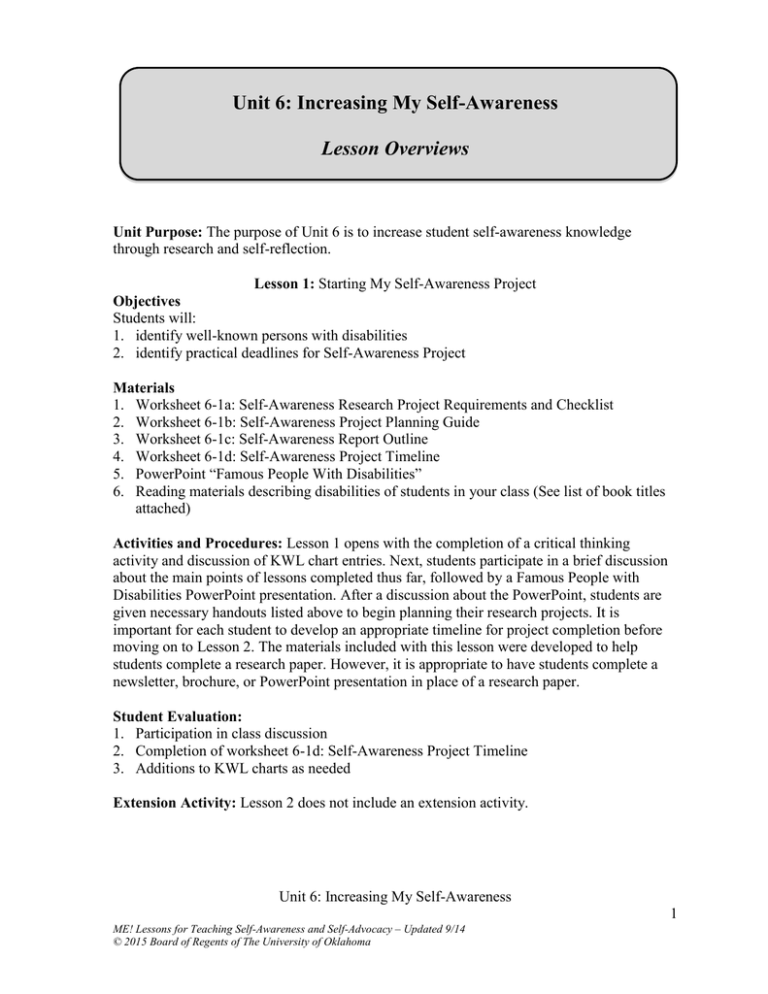
Unit 6: Increasing My Self-Awareness Lesson Overviews Unit Purpose: The purpose of Unit 6 is to increase student self-awareness knowledge through research and self-reflection. Lesson 1: Starting My Self-Awareness Project Objectives Students will: 1. identify well-known persons with disabilities 2. identify practical deadlines for Self-Awareness Project Materials 1. Worksheet 6-1a: Self-Awareness Research Project Requirements and Checklist 2. Worksheet 6-1b: Self-Awareness Project Planning Guide 3. Worksheet 6-1c: Self-Awareness Report Outline 4. Worksheet 6-1d: Self-Awareness Project Timeline 5. PowerPoint “Famous People With Disabilities” 6. Reading materials describing disabilities of students in your class (See list of book titles attached) Activities and Procedures: Lesson 1 opens with the completion of a critical thinking activity and discussion of KWL chart entries. Next, students participate in a brief discussion about the main points of lessons completed thus far, followed by a Famous People with Disabilities PowerPoint presentation. After a discussion about the PowerPoint, students are given necessary handouts listed above to begin planning their research projects. It is important for each student to develop an appropriate timeline for project completion before moving on to Lesson 2. The materials included with this lesson were developed to help students complete a research paper. However, it is appropriate to have students complete a newsletter, brochure, or PowerPoint presentation in place of a research paper. Student Evaluation: 1. Participation in class discussion 2. Completion of worksheet 6-1d: Self-Awareness Project Timeline 3. Additions to KWL charts as needed Extension Activity: Lesson 2 does not include an extension activity. Unit 6: Increasing My Self-Awareness 1 ME! Lessons for Teaching Self-Awareness and Self-Advocacy – Updated 9/14 © 2015 Board of Regents of The University of Oklahoma Lesson 2: Completing My Self-Awareness Project Objectives Students will: 1. complete tasks as dictated by project timeline 2. use available resources to complete required research Materials 1. Worksheet 6-1a: Self-Awareness Research Project Requirements and Checklist 2. Worksheet 6-1b: Self-Awareness Project Planning Guide 3. Worksheet 6-1c: Self-Awareness Report Outline 4. Worksheet 6-1d: Self-Awareness Project Timeline 5. Reading materials describing disabilities of students in your class (See list of book titles attached) Activities and Procedures: Review KWL charts, specifically, the information students have listed in the “want to know” column. Students use the remaining class time to work on research projects as the teacher moves around the room answering questions and keeping students on task. Repeat this lesson as needed to provide students time and opportunity to complete their projects. Student Evaluation: 1. Completion of work based on due dates from worksheet 6-1d: Self-Awareness Project Timeline Extension Activity: Lesson 2 does not include an extension activity. Lesson 3: Presenting My Self-Awareness Project Objectives Students will: 1. give oral presentation over completed project 2. complete peer-evaluations 3. complete self-evaluations Materials 1. Worksheet 6-3a: Self-Awareness Project Self Evaluation Form 2. Worksheet 6-3b: Self-Awareness Project Peer Evaluation Form 3. Completed Self-Awareness Projects Activities and Procedures: Once students have completed their research projects, move on to Lesson 3. This lesson opens by revisiting the critical thinking activity from the beginning of the unit. Next, distribute and discuss worksheets 6-3b: Self-Awareness Project Peer Unit 6: Increasing My Self-Awareness 2 ME! Lessons for Teaching Self-Awareness and Self-Advocacy – Updated 9/14 © 2015 Board of Regents of The University of Oklahoma Evaluation Form and 6-3a: Self-Awareness Self Evaluation Form. Once students have had the opportunity to ask clarifying questions about worksheets, begin student presentations. Unit 6 does not include a Knowledge Quiz. Student Evaluation: 1. Completion of project presentation 2. Completion of peer-evaluations 3. Completion of self-evaluation 4. Participation in class discussion Extension Activity: Use a camera to record student presentations. Have each student watch his/her presentation before and/or while completing worksheet 6-3a: Self-Awareness Self Evaluation Form. Unit 6: Increasing My Self-Awareness 3 ME! Lessons for Teaching Self-Awareness and Self-Advocacy – Updated 9/14 © 2015 Board of Regents of The University of Oklahoma Lesson 1 – Starting My Self-Awareness Project Unit 6: Increasing My Self-Awareness COMMON CORE STANDARDS - High School Language Arts (Grades 9, 10, 11, & 12) – Writing CCSS.ELA-Literacy.W.11-12.1 Write arguments to support claims in an analysis of substantive topics or texts, using valid reasoning and relevant and sufficient evidence. d. CCSS.ELA-Literacy.W.11-12.1d Establish and maintain a formal style and objective tone while attending to the norms and conventions of the discipline in which they are writing. e. CCSS.ELA-Literacy.W.11-12.1e Provide a concluding statement or section that follows from and supports the argument presented. CCSS.ELA-Literacy.W.11-12.2 Write informative/explanatory texts to examine and convey complex ideas, concepts, and information clearly and accurately through the effective selection, organization, and analysis of content. f. CCSS.ELA-Literacy.W.11-12.2f Provide a concluding statement or section that follows from and supports the information or explanation presented (e.g., articulating implications or the significance of the topic). CCSS.ELA-Literacy.W.11-12.3 Write narratives to develop real or imagined experiences or events using effective technique, well-chosen details, and well-structured event sequences. a. CCSS.ELA-Literacy.W.11-12.3a Engage and orient the reader by setting out a problem, situation, or observation, establishing one or multiple point(s) of view, and introducing a narrator and/or characters; create a smooth progression of experiences or events. c. CCSS.ELA-Literacy.W.11-12.3c Use a variety of techniques to sequence events so that they build on one another to create a coherent whole. e. CCSS.ELA-Literacy.W.11-12.3e Provide a conclusion that follows from and reflects on what is experienced, observed, or resolved over the course of the narrative. CCSS.ELA-Literacy.W.11-12.5 Develop and strengthen writing as needed by planning, revising, editing, rewriting, or trying a new approach, focusing on addressing what is most significant for a specific purpose and audience. CCSS.ELA-Literacy.W.11-12.7 Conduct short as well as more sustained research projects to answer a question (including a self-generated question) or solve a problem; narrow or broaden the inquiry when appropriate; synthesize multiple sources on the subject, demonstrating understanding of the subject under investigation. Unit 6: Increasing My Self-Awareness 4 ME! Lessons for Teaching Self-Awareness and Self-Advocacy – Updated 9/14 © 2015 Board of Regents of The University of Oklahoma Lesson 1 – Starting My Self-Awareness Project CCSS.ELA-Literacy.W.11-12.8 Gather relevant information from multiple authoritative print and digital sources, using advanced searches effectively; assess the usefulness of each source in answering the research question; integrate information into the text selectively to maintain the flow of ideas, avoiding plagiarism and following a standard format for citation. Reading Informational Texts CCSS.ELA-Literacy.RI.9-10.6 Determine an author’s point of view or purpose in a text and analyze how an author uses rhetoric to advance that point of view or purpose. CCSS.ELA-Literacy.RI.9-10.7 Analyze various accounts of a subject told in different mediums (e.g., a person’s life story in both print and multimedia), determining which details are emphasized in each account. Language CCSS.ELA-Literacy.L.9-10.1 Demonstrate command of the conventions of standard English grammar and usage when writing or speaking. a. CCSS.ELA-Literacy.L.9-10.1a Use parallel structure. CCSS.ELA-Literacy.L.9-10.2 Demonstrate command of the conventions of standard English capitalization, punctuation, and spelling when writing. a. CCSS.ELA-Literacy.L.9-10.2a Use a semicolon (and perhaps a conjunctive adverb) to link two or more closely related independent clauses. b. CCSS.ELA-Literacy.L.9-10.2b Use a colon to introduce a list o quotation. Speaking and Listening CCSS.ELA-Literacy.SL.9-10.1 Initiate and participate effectively in a range of collaborative discussions (one-on-one, in groups, and teacher-led) with diverse partners on grades 9–10 topics, texts, and issues, building on others’ ideas and expressing their own clearly and persuasively. a. CCSS.ELA-Literacy.SL.9-10.1a Come to discussions prepared, having read and researched material under study; explicitly draw on that preparation by referring to evidence from texts and other research on the topic or issue to stimulate a thoughtful, well-reasoned exchange of ideas. b. CCSS.ELA-Literacy.SL.9-10.1b Work with peers to set rules for collegial discussions and decision-making (e.g., informal consensus, taking votes on key issues, presentation of alternate views), clear goals and deadlines, and individual roles as needed. c. CCSS.ELA-Literacy.SL.9-10.1c Propel conversations by posing and responding to questions that relate the current discussion to broader themes or larger ideas; actively incorporate others into the discussion; and clarify, verify, or challenge ideas and conclusions. d. CCSS.ELA-Literacy.SL.9-10.1d Respond thoughtfully to diverse perspectives, Unit 6: Increasing My Self-Awareness 5 ME! Lessons for Teaching Self-Awareness and Self-Advocacy – Updated 9/14 © 2015 Board of Regents of The University of Oklahoma Lesson 1 – Starting My Self-Awareness Project summarize points of agreement and disagreement, and, when warranted, qualify or justify their own views and understanding and make new connections in light of the evidence and reasoning presented. CCSS.ELA-Literacy.SL.9-10.2 Integrate multiple sources of information presented in diverse media or formats (e.g., visually, quantitatively, orally) evaluating the credibility and accuracy of each source. CCSS.ELA-Literacy.SL.9-10.4 Present information, findings, and supporting evidence clearly, concisely, and logically such that listeners can follow the line of reasoning and the organization, development, substance, and style are appropriate to purpose, audience, and task. CCSS.ELA-Literacy.SL.9-10.6 Adapt speech to a variety of contexts and tasks, demonstrating command of formal English when indicated or appropriate. Reading Literature CCSS.ELA-Literacy.RL.9-10.7 Analyze the representation of a subject or a key scene in two different artistic mediums, including what is emphasized or absent in each treatment (e.g., Auden’s “Musée des Beaux Arts” and Breughel’s Landscape with the Fall of Icarus). CCSS.ELA-Literacy.RL.9-10.9 Analyze how an author draws on and transforms source material in a specific work (e.g., how Shakespeare treats a theme or topic from Ovid or the Bible or how a later author draws on a play by Shakespeare). Unit 6: Increasing My Self-Awareness 6 ME! Lessons for Teaching Self-Awareness and Self-Advocacy – Updated 9/14 © 2015 Board of Regents of The University of Oklahoma Lesson 1 – Starting My Self-Awareness Project Lesson 1 Starting My Self-Awareness Project TIME: 45-60 minutes OBJECTIVES Students will: 1. Identify well known persons with disabilities 2. Identify practical deadlines for Self-Awareness Project MATERIALS 1. Worksheet 6-1a: Self-Awareness Research Project Requirements and Checklist 2. Worksheet 6-1b: Self-Awareness Project Planning Guide 3. Worksheet 6-1c: Self-Awareness Report Outline 4. Worksheet 6-1d: Self-Awareness Project Timeline 5. Power Point “Famous People With Disabilities” 6. Reading materials describing disabilities of students in your class (See list of book titles attached) LESSON OPENING Critical thinking: Read the following scenario to students. Have students identify the key issues/problems and solutions. Jeremy is a high school student with a learning disability; he is currently enrolled in Biology. Jeremy has failed the last two tests and will fail the class if he does not do well on the next test. Jeremy talks to Mr. Wilson, his Biology teacher, and tells him that he is concerned about failing the class. Mr. Wilson asks Jeremy what he wants him to do to help him succeed in class. Then Mr. Wilson asks Jeremy why he should get special treatment with his class work. Jeremy feels embarrassed and does not know how to answer Mr. Wilson’s questions. Provide students time and opportunity to respond to the story. Record the solutions students identify in the space below or somewhere in the classroom. Students will need to revisit these solutions at the end of this unit. Unit 6: Increasing My Self-Awareness 7 ME! Lessons for Teaching Self-Awareness and Self-Advocacy – Updated 9/14 © 2015 Board of Regents of The University of Oklahoma Lesson 1 – Starting My Self-Awareness Project Problems ________________________________ ____________________________________ ________________________________ ____________________________________ ________________________________ ____________________________________ ________________________________ ____________________________________ ________________________________ ____________________________________ Instruct students to think about this scenario as they work through Unit 6. Inform them that at the end of the unit the class will discuss this situation again to see if anyone has come up with new solutions. o Solutions Please get out your personal KWL charts from Unit 5 and let’s review what you learned about communicating with others. Take a minute to let students share their thoughts and questions about the information from previous lessons on their individual KWL charts. Note to teacher: It is important to emphasize to students that it is okay to have some unanswered topics listed in the “want to know column” at this point. Encourage students to think about these topics as they complete their projects in this unit. It is important that you, the teacher, make note of these unanswered questions and find ways to bring these topics into the lessons as students work on their research projects. o So far, we have learned about self-awareness, self-advocacy, special education, IEP’s, communication skills, and some history of disability. Now we will start talking about different types of disabilities and some of the people who have disabilities, including the people in this classroom. o Think about things that you are very good at doing or are easy for you, maybe a talent you have, a school subject, a sport… I know I am great at-----------(insert something that is easy for you to do and discuss it). Someone else share an example of something you do well. Take a minute to let students share their thoughts about this question. o Now, let’s think of something that is difficult for you to do. I know that I have to work very hard at------------------ (insert something that is hard for you to do and discuss it). Someone else share an example of something that is difficult for you. Take a minute to let students share their thoughts about this question. Unit 6: Increasing My Self-Awareness 8 ME! Lessons for Teaching Self-Awareness and Self-Advocacy – Updated 9/14 © 2015 Board of Regents of The University of Oklahoma Lesson 1 – Starting My Self-Awareness Project o Sometimes things can be difficult for a person because of a disability they have. Different disabilities affect people in different ways. Do you know enough about your disability to know how it affects your abilities at school, home or anywhere else you spend time? Take a minute and think about that question. Provide an opportunity for students to share their thoughts about this question. o During Unit 2 you had the opportunity to take the information you learned and combine it with what you know about yourself. The “Creating My History” activity gave you the chance to combine some of that information and write a brief history about you. I want you to take a minute and think about these questions. o While you were working on your history, did you include a description about your disability? o Did you feel like you knew a lot about your disability? o Did you find yourself wanting to know more about your disability? o Did you spend much time wondering how having a disability would affect your life now and in the future? Take time to let students share their thoughts about the questions you just asked. PROCEDURE 1. Teacher discussion: Introduce famous people with disabilities. o Many people have disabilities. Some disabilities you can see, like a person who uses a wheelchair. Others are not visible, you cannot see them, but they affect how a person learns or thinks, like a learning disability. Some disabilities are caused by a medical condition, like diabetes or epilepsy, and might be helped by taking medication. You will learn more about disabilities and how they affect people’s lives as we complete this unit. o Having a disability does not mean that something is wrong with a person. Having a disability does not prevent a person from being successful. Many people with disabilities are famous because of their great success in life. We are going to talk about a few of those people today. Some of the people we will talk about have worked hard to be able to do things that are difficult for them in order to reach their goals; some have learned how to work around it. They may get help from other people. They may have focused on their strengths or talents and used those to find a career in which they could succeed. You will have a chance to learn more about people with Unit 6: Increasing My Self-Awareness 9 ME! Lessons for Teaching Self-Awareness and Self-Advocacy – Updated 9/14 © 2015 Board of Regents of The University of Oklahoma Lesson 1 – Starting My Self-Awareness Project disabilities who have accomplished great things as you work on your project. Right now, I am going to introduce you to a few of these people. Note to teacher: Use the “Famous People With Disabilities” Power Point to accompany discussion. The following links may also provide valuable information. 1. http://www.authorstream.com/Presentation/eckre-251306-celebrities-disabilitiesfinal2-final-entertainment-ppt-powerpoint/ 2. http://www.disabilityresources.org/FAMOUS.html (multiple links of famous people) 3. http://www.increasebrainpower.com/famouspeoplewithlearningdisabilities.html (list of famous people with ADD, ADHD and LD) 4. http://www.waisman.wisc.edu/ (multiple links to resources on famous people with disabilities and listed by the disabilities) 5. http://www.tampagov.net/dept_mayor/mayors_alliance/famous_persons/index.asp (alphabetized list of MANY famous people with disabilities) 6. http://www.iidc.indiana.edu/cedir/kidsweb/fpwdinfo.html 7. http://www.download-free-pdf.com/famous-people-with-disabilities-poster.pdf 8. http://www.disabled-world.com/artman/publish/article_0060.shtml Discussion point(s): After completing the presentation, ask students the following questions and provide them an opportunity to respond and discuss. o How many of you knew some of these people had disabilities? o Does this surprise you? Why or why not? o What are some things that you thought of when you heard this information about these people? o What questions can I answer for you about what we have covered so far? 2. Introduce the research project and necessary project worksheets. o Understanding your abilities and disability is crucial! You need to understand your disability and the ways it might impact your learning. Today we are going to start a project that provides you an opportunity to learn about your abilities and disability. We will start the project today and then spend the next few class sessions working on it. Handout: Distribute copy of worksheet 6-1a: Self-Awareness Research Project Requirements and Checklist. o Here is a handout describing a project you will complete. You will need to identify and describe your abilities and disability. You will be able to complete part of the Unit 6: Increasing My Self-Awareness 10 ME! Lessons for Teaching Self-Awareness and Self-Advocacy – Updated 9/14 © 2015 Board of Regents of The University of Oklahoma Lesson 1 – Starting My Self-Awareness Project project with information you already know. For some of the project you will need to do additional research. For example, you must research people who have disabilities, find out information about strengths and things that can be difficult because of a disability. You will talk to others, read, and use the internet while completing your research. o I have several handouts that we will go over that will help you organize your research and guide your writing. Finally, when everything in your project is complete you will present it to the class. Let’s look at the handouts I am giving you now. Handout: Distribute copies of worksheet 6-1b: Self-Awareness Project Planning Guide and/or 6-1c: Self-Awareness Project-Report Outline. Note to teacher: The worksheet you choose depends on you and your students’ needs. It might be a good idea to let students look at both 6-1b and 6-1c and choose the one that works best for their individual needs. • Review the project forms in detail with students to answer any questions students may have. Handout worksheets: Distribute copies of worksheet 6-1d: Self-Awareness Project Timeline • Review the timeline in detail and fill in the due dates as a class. You might consider having students select individualized dates based on student need. • Post the example of the Self-Awareness Project Timeline you completed as a reminder of all due dates. LESSON CLOSURE o Today we have learned about famous people who have disabilities. 1. Who can tell me the names of some of the people we discussed? 2. What are some of the disabilities these people have? 3. Did their disabilities keep them from being successful? o We also discussed the research timeline and requirements. Are there any questions about the timeline and the requirements? o During our next lesson you will start working on your project. It would be a good idea to spend some time between now and then thinking about how you will complete your research. Unit 6: Increasing My Self-Awareness 11 ME! Lessons for Teaching Self-Awareness and Self-Advocacy – Updated 9/14 © 2015 Board of Regents of The University of Oklahoma Lesson 1 – Starting My Self-Awareness Project Briefly, review the planned schedule according to the project timeline. STUDENT EVALUATION 1. Participation in class discussion 2. Completion of worksheet 6-1d: Self-Awareness Project Timeline 3. Additions to KWL charts as needed Unit 6: Increasing My Self-Awareness 12 ME! Lessons for Teaching Self-Awareness and Self-Advocacy – Updated 9/14 © 2015 Board of Regents of The University of Oklahoma Lesson 2 – Completing My Self-Awareness Project Lesson 2 Completing My Self-Awareness Project TIME: 45-60 minutes OBJECTIVES Students will: 1. complete tasks as dictated by project timeline 2. use available resources to complete required research MATERIALS 1. Worksheet 6-1a: Self-Awareness Research Project Requirements and Checklist 2. Worksheet 6-1b: Self-Awareness Project Planning Guide 3. Worksheet 6-1c: Self-Awareness Report Outline 4. Worksheet 6-1d: Self-Awareness Project Timeline 5. Reading materials describing disabilities of students in your class (See list of book titles attached) 6. Sample Self Awareness Project Power Point (Modification) LESSON OPENING o Take a minute to look at your individual KWL chart. Pay close attention to the information you have listed in the “want to know” column. Today you are going to work on your selfawareness projects. This is a good opportunity for you to find some answers to the questions you have listed in the “want to know” column. PROCEDURE Note to teacher: The time required to complete the Self-Awareness Project will vary based on student need and the format you require your students to use for the project. We recommend repeating the format of lesson 2 as many times as you feel is appropriate for your students. o Please take out worksheet 6-1d: Self-Awareness Project Timeline that we completed during our last session. Take a minute to look at the due dates for your project. 1. Review the worksheets, answer student questions and have them begin their projects. o Based on the due dates on your timeline, what do you need to work on today? • Review resources available to students as they work on their project. • Instruct students to begin working on their project. Unit 6: Increasing My Self-Awareness 13 ME! Lessons for Teaching Self-Awareness and Self-Advocacy – Updated 9/14 © 2015 Board of Regents of The University of Oklahoma Lesson 2 – Completing My Self-Awareness Project o Today as you are working, I will be coming around to check your outline or planning guide. Please keep your worksheets out to help guide you while you work and so I can check them as I move around the room. 2. Monitor the students while they work and provide necessary feedback. LESSON CLOSURE Review the project timeline. Check student’s work to ensure they are keeping up with timeline requirements. Assign homework for project if appropriate. Have students put materials away. Remind students to put their papers in their binders. STUDENT EVALUATION 1. Completion of work based on due dates from worksheet 6-1d: Self-Awareness Project Timeline. Unit 6: Increasing My Self-Awareness 14 ME! Lessons for Teaching Self-Awareness and Self-Advocacy – Updated 9/14 © 2015 Board of Regents of The University of Oklahoma Lesson 3 – Presenting My Self-Awareness Project Lesson 3 Presenting My Self-Awareness Project TIME: 45-60 minutes OBJECTIVES Students will: 1. give oral presentation over completed project 2. complete peer-evaluations 3. complete self-evaluations MATERIALS 1. Worksheet 6-1e: Self-Awareness Project Peer Evaluation Form 2. Worksheet 6-1f: Self-Awareness Project Self Evaluation Form 3. Completed Self-Awareness Projects LESSON OPENING Critical thinking: Read the following scenario to students. Have them identify the key issues/problems and solutions. Jeremy is a high school student with a learning disability; he is currently enrolled in Biology. Jeremy has failed the last two tests and will fail the class if he does not do well on the next test. Jeremy talks to Mr. Wilson, his Biology teacher, and tells him that he is concerned about failing the class. Mr. Wilson asks Jeremy what he wants him to do to help him succeed in class. Then Mr. Wilson asks Jeremy why he should get special treatment with his class work. Jeremy feels embarrassed and does not know how to answer Mr. Wilson’s questions. Provide students time and opportunity to respond to the story. Problems Solutions ________________________________ ____________________________________ ________________________________ ____________________________________ ________________________________ ____________________________________ ________________________________ ____________________________________ ________________________________ ____________________________________ Unit 6: Increasing My Self-Awareness 15 ME! Lessons for Teaching Self-Awareness and Self-Advocacy – Updated 9/14 © 2015 Board of Regents of The University of Oklahoma Lesson 3 – Presenting My Self-Awareness Project Provide students time and opportunity to discuss the problems and solutions they identified prior to completing their projects compared to the ones they identified today. PROCEDURE Handout: Distribute worksheet 6-3b: Self-Awareness Project Peer Evaluation Form. Review worksheet in detail with students and provide time and opportunity for questions and discussion as needed. Have each student present his/her project. Provide the class time to complete Worksheet 6-1e: Self-Awareness Project Peer Evaluation Form before moving on to the next presentation. Complete this process until each student has had the opportunity to present. Handout: Distribute worksheet 6-1f: Self-Awareness Self Evaluation Form. Review worksheet in detail with students and provide time and opportunity for questions and discussion as needed. Provide students time to complete worksheet 6-1f: Self-Awareness Self Evaluation Form. Extension Activity: Video record each student presentation and have students watch their own presentation before completing worksheet 6-1f: Self-Awareness Self Evaluation Form. LESSON CLOSURE o Now that you each have a good understanding of your strengths and your disability, you can use that information to self-advocate. During our next unit we will talk about how you can each advocate for yourself during high school. You will each select one of your classes to practice asking for accommodations. Between now and then, I want you to start thinking about what class you will select for the activities in unit 7. We will talk about the activities more during out next class session. Remind students to turn in all completed evaluations before leaving class. Unit 6: Increasing My Self-Awareness 16 ME! Lessons for Teaching Self-Awareness and Self-Advocacy – Updated 9/14 © 2015 Board of Regents of The University of Oklahoma Lesson 3 – Presenting My Self-Awareness Project STUDENT EVALUATION 1. Completion of project presentation 2. Completion of peer-evaluations 3. Completion of self-evaluation 4. Participation in class discussion Unit 6: Increasing My Self-Awareness 17 ME! Lessons for Teaching Self-Awareness and Self-Advocacy – Updated 9/14 © 2015 Board of Regents of The University of Oklahoma
